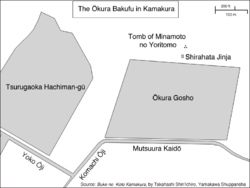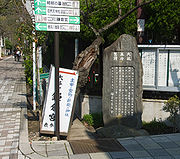
Okura Bakufu
Encyclopedia


Kamakura shogunate
The Kamakura shogunate was a military dictatorship in Japan headed by the shoguns from 1185 to 1333. It was based in Kamakura. The Kamakura period draws its name from the capital of the shogunate...
Minamoto no Yoritomo
Minamoto no Yoritomo
was the founder and the first shogun of the Kamakura Shogunate of Japan. He ruled from 1192 until 1199.-Early life and exile :Yoritomo was the third son of Minamoto no Yoshitomo, heir of the Minamoto clan, and his official wife, a daughter of Fujiwara no Suenori, who was a member of the...
's first government. It took its name from the location in Kamakura
Kamakura, Kanagawa
is a city located in Kanagawa Prefecture, Japan, about south-south-west of Tokyo. It used to be also called .Although Kamakura proper is today rather small, it is often described in history books as a former de facto capital of Japan as the seat of the Shogunate and of the Regency during the...
, Kanagawa prefecture
Kanagawa Prefecture
is a prefecture located in the southern Kantō region of Japan. The capital is Yokohama. Kanagawa is part of the Greater Tokyo Area.-History:The prefecture has some archaeological sites going back to the Jōmon period...
, where Yoritomo's palace used to stand. Ōkura in Kamakura is defined as the area comprised between Tsurugaoka Hachiman-gū, the Asaina Pass, the Namerigawa river and the Zen
Zen
Zen is a school of Mahāyāna Buddhism founded by the Buddhist monk Bodhidharma. The word Zen is from the Japanese pronunciation of the Chinese word Chán , which in turn is derived from the Sanskrit word dhyāna, which can be approximately translated as "meditation" or "meditative state."Zen...
temple of Zuisen-ji
Zuisen-ji
is a Buddhist temple of the Rinzai sect in Nikaidō's near Kamakura, Japan. During the Muromachi period it was the family temple of the Ashikaga rulers of Kamakura : four of the five kubō are buried there in a private cemetery closed to the public and first kubō Ashikaga Motouji's is also known...
. The complex extended approximately from the Mutsuura Kaidō to the tomb of Minamoto no Yoritomo
Tomb of Minamoto no Yoritomo
The is a monument in Kamakura, Kanagawa, Japan, located some hundred meters north of the site where the palace called Ōkura Bakufu, seat of Minamoto no Yoritomo's government, once stood. Although there is no evidence his remains are actually there, it is commonly assumed to be the resting place...
, and from the Nishi Mikado River (or Tsurugaoka Hachiman-gū) to the Higashi Mikado river (about 800x600 meters). A black stone stele marks the center of the area where Yoritomo's government used to stand and carries the words:
820 years ago in 1180 Minamoto no Yoritomo built his mansion here. Consolidated his power, he would later rule from it, and his government was therefore called Ōkura Bakufu. He was succeeded by his sons YoriieMinamoto no Yoriiewas the second shogun of Japan's Kamakura shogunate, and the first son of first shogun Yoritomo.- Life :Born from Tokimasa's daughter Hōjō Masako at Hiki Yoshikazu's residence in Kamakura, Yoriie had as wet nurses the wives of powerful men like Hiki himself and Kajiwara Kagetoki, and Hiki's...
and SanetomoMinamoto no SanetomoMinamoto no Sanetomo was the third shogun of the Kamakura shogunate Sanetomo was the second son of the founder of the Kamakura shogunate Minamoto no Yoritomo, his mother was Hōjō Masako, and his older brother was the second Kamakura shogun Minamoto no Yoriie.His childhood name was...
, and this place remained the seat of the government for 46 years until 1225, when his wife Hōjō MasakoHojo Masakowas the eldest child of Hōjō Tokimasa by his wife Hōjō no Maki, the first shikken, or regent, of the Kamakura shogunate. She was the sister of Hōjō Yoshitoki, and was married to Minamoto no Yoritomo, the first shogun of the Kamakura period...
died. It was then transferred to .
Erected in March 1917 by The Kamakura-machi Seinendan

Wada Yoshimori
was an early Kamakura period military commander. A gokenin of the Kamakura shogunate, he was the first director of the Samurai-dokoro.He was the son of Miura Yoshiaki and grandson of Sugimoto Yoshimune, making him a descendant of the Heike. Among his sons were Wada Yoshinao, Asahina Yoshihide, and...
rebelled against the Hōjō regents in the so-called Wada Kassen and his famous son Asahina Yoshihide
Asahina Yoshihide
, also known as , was a Japanese warrior of the early 13th century, and the son of Wada Yoshimori. His name stems from the fact he used to live in . Though very likely a historical figure, Yoshihide appears in literature and in Kabuki as a somewhat superhuman legendary character...
stormed into the Ōkura Bakufu, burning it into the ground. It was later rebuilt. Many powerful Gokenin
Gokenin
A was initially a vassal of the shogunate of the Kamakura and the Muromachi periods. In exchange for protection and the right to become shugo or jitō , in times of peace a gokenin had the duty to protect the imperial court and Kamakura, in case of war had to fight with his forces under the...
had their mansions in Ōkura, which was therefore one of the most important parts of medieval Kamakura. The palace gave their names also to at least two other Kamakura neighborhoods, Nishi Mikado
Nishi Mikado
is the name of a neighborhood in Kamakura, a city located in Kanagawa, Japan, about 50 km south-south-west of Tokyo. Nishi Mikado lies north-east of Tsurugaoka Hachiman-gū.- Etymology of the name:...
and Higashi Mikado. The two names mean respectively "Western Gate" and "East Gate", from the name of the nearest Ōkura Bakufu gate. The area now called used to be called Higashi Mikado, and the name is still sometimes used. Kita Mikado still exists as well but does not constitute a chō.

